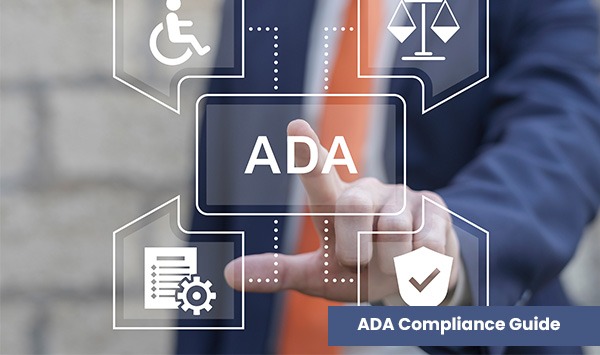In today’s digital age, having an accessible website is not just a best practice – it’s a legal and ethical imperative. The Americans with Disabilities Act (ADA) mandates that digital spaces, like physical ones, must be inclusive and usable by individuals with disabilities. As more services, products, and information move online, ensuring your website meets ADA compliance standards is essential for reaching all users and avoiding potential legal repercussions.
This guide will walk you through the key aspects of ADA website compliance, offering practical steps to make your website accessible to everyone, regardless of their abilities.
What is ADA Compliance?
ADA compliance means following the Americans with Disabilities Act to ensure that people with disabilities have equal access to public spaces, services, and digital content. Title III of the ADA requires that places of public accommodation, including websites, be accessible to individuals with disabilities. This means your website should be usable by people with various disabilities, including visual, auditory, motor, and cognitive impairments.
It applies to buildings, websites, transportation, and employment, requiring accessibility in design and communication.
The Five Titles of the ADA
- Employment Discrimination: Title I prohibits employment discrimination against individuals with disabilities, ensuring equal opportunities in the job application process, hiring, and other employment practices.
- Public Services: Title II mandates equal access to all public services and transportation for individuals with disabilities, ensuring that state and local governments accommodate their needs.
- Public Accommodations: Title III requires that all public accommodations and commercial facilities be accessible to individuals with disabilities.
- Telecommunications: Title IV focuses on telecommunications, requiring accessible telephone and internet services for individuals with hearing and speech disabilities.
- Miscellaneous: Title V includes miscellaneous provisions, such as prohibiting retaliation against individuals with disabilities asserting their rights under the ADA.
The Definition of a Disability Under the ADA
Under the Americans with Disabilities Act (ADA), a disability is defined broadly to ensure protection for individuals facing a wide range of challenges. According to the ADA, a person with a disability is someone who:
- Has a physical or mental impairment that substantially limits one or more major life activities,
- Has a record of such an impairment, or
- Is regarded as having such an impairment
Why Are ADA Website Compliance Lawsuits on the Rise?
ADA website compliance lawsuits are increasing due to greater awareness of digital accessibility rights and the growing reliance on the internet for essential services like shopping, healthcare, and education. Many businesses still fail to meet accessibility standards, leaving individuals with disabilities unable to use their websites effectively.
As a result, users are taking legal action to demand equal access. Additionally, courts have increasingly ruled that websites fall under Title III of the ADA, especially for businesses considered public accommodations. The rise in litigation reflects both the legal accountability and the societal push for inclusive digital experiences.
Best Practices for Achieving ADA Website Compliance
1. Follow WCAG 2.1 Guidelines (Level AA)
- Use the Web Content Accessibility Guidelines (WCAG) 2.1 Level AA as your compliance standard.
- Ensure your website is Perceivable, Operable, Understandable, and Robust (POUR) for all users.
2. Use Semantic HTML
- Build your site using clean, semantic HTML that clearly defines structure (e.g., headings, lists, tables).
- Use HTML tags properly to help screen readers and assistive technologies interpret content correctly.
3. Make Content Keyboard Accessible
- Ensure all functions (navigation, form submissions, modals, etc.) can be performed using only a keyboard.
- Provide visible focus indicators so users can see where they are on the page.
4. Add Alt Text to All Images
- Provide descriptive alternative text (alt text) for all images.
- Ensure that decorative images are marked as such to be skipped by screen readers.
5. Ensure Adequate Color Contrast
- Maintain a minimum contrast ratio of 4.5:1 between text and background.
- Avoid using color alone to convey meaning (e.g., red text for errors without an icon or label).
6. Use Accessible Forms
- Label all input fields clearly and associate them with instructions.
- Make error messages descriptive and accessible, with suggestions for correction.
7. Design Responsive and Scalable Interfaces
- Ensure your website is responsive and works well on all devices and screen sizes.
- Allow users to zoom up to 200% without loss of content or functionality.
8. Test with Screen Readers and Assistive Tools
- Test your site using tools like NVDA, JAWS, or VoiceOver to experience how users with disabilities interact with it.
- Combine manual and automated testing to catch both obvious and nuanced issues.
9. Allow Text Resizing
- Use Relative Units: Design text with relative units like em or % instead of fixed units like px to allow smooth resizing without breaking the layout.
- Support Browser Zoom: Ensure your website or app allows users to zoom text up to 200% without loss of content or functionality.
10. Create an Accessibility Statement
Publish a clear accessibility statement outlining your commitment to accessibility, known limitations, and contact options for users needing help.
ADA Website Compliance Checklist
Here are the main key points for the compliance checklist.
- General Accessibility
- Text & Content
- Keyboard Navigation
- Forms
- Multimedia (Audio & Video)
- Visual Design
- ARIA & HTML Elements
- Error Prevention
- Site Structure
- Testing and Maintenance
What Types of Businesses Must Comply with the ADA?
Businesses that serve the public must comply with the ADA, including
- Private employers with 15 or more employees
- Restaurants and bars
- Retail stores and shopping centers
- Movie theaters and entertainment venues
- Medical offices and private healthcare providers
- Banks and financial institutions
- Gyms and fitness centers
- Private schools and daycare centers
- Museums, libraries, and recreational facilities
- Transportation providers (public and private)
- Online businesses and e-commerce websites
- State and local government agencies
- Telecommunication companies
What’s the Risk of Non-Compliance?
Failing to comply with the Americans with Disabilities Act (ADA) can have serious consequences for businesses, both legally and financially. Beyond the potential for lawsuits, non-compliance can damage your brand’s reputation and exclude a significant portion of your audience.
Why ADA Compliance Matters?
1. Legal Obligations
In recent years, there has been a surge in lawsuits targeting businesses for inaccessible websites. For instance, in 2023 alone, a New York-based law firm filed over 1,100 web accessibility lawsuits, highlighting the increasing legal risks for non-compliant websites.
2. Ethical Responsibility
Providing an inclusive digital experience ensures that all individuals, regardless of their abilities, can access your content and services. This fosters a more inclusive society and demonstrates corporate social responsibility.
3. Business Benefits
Accessible websites often lead to improved user experience, broader audience reach, and enhanced brand reputation. Moreover, they can improve SEO rankings, as search engines favor well-structured and accessible sites.
How to Test for ADA Compliance?
Regular testing is crucial to maintain accessibility standards. Utilize a combination of automated tools and manual testing to ensure comprehensive coverage. Automated tools can quickly identify obvious issues, while manual testing allows for a more nuanced assessment.
ADA compliance is not a one-time effort but an ongoing commitment. Regularly update your website, train your team on accessibility best practices, and stay informed about evolving guidelines to ensure continuous compliance. You can test your website on ADA website compliance checker.
Find and Fix Accessibility Issues with Tranistics
Ensure your digital platforms are inclusive by identifying and resolving accessibility barriers with Tranistics. Our expert team uses industry standards like WCAG to audit your websites and applications, helping you address issues such as poor color contrast, missing alt text, and keyboard navigation errors. With Tranistics, make your content accessible to all users, including those with disabilities, while staying compliant with ADA guidelines. Contact us now!





